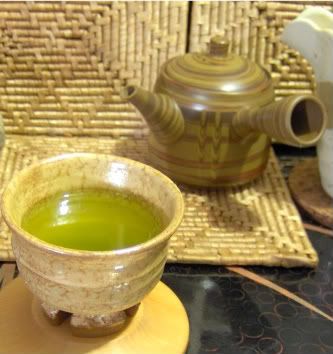OK folks... a few thoughts here on Japanese wares...............
Many of the "typical" glazes from sort of "famous" locations in Japan can be bought at one of the local ceramics suppliers in a pre-made format. Just add water and apply. So the glaze looking "correct" to the localle is not a guarantee of authenticity or a particular artist.
For lower priced pieces, many potters often use these commercial supplier preparations .... because making glazes by hand from stuff like rice husk ash, wood ash, and crudely curshed stone is very difficult and labor intensive. On the "master's work" (the high priced stuff) the glazes might certainly be composed from hand processed raw materials. You usually clearly
pay for this labor and authenticity.
I can tell you right now... if anyone wants a guinomi with the EXACT classic Mashiko Kaki (persimmon) glaze on it...
I can do that for you. I have a supply of the single powdered stone that is that glaze. You can put it right next to one fired at the Hamada kiln in Mashiko. Same glaze. (In fact my stone supply is old and nice... Mashiko's Kumiai (Cooperative) is running out of the good stone now!)
From many materials suppliers in Japan you can now purchase clay (bodies) from a huge number of local areas. So a potter in Mashiko can easily get a clay from Shigaraki or Tamba or wherever to make pieces with. So the clay body matching is not always a problem either.
Matching a kiln stamp
almost exactly is kinda' easy. All you need is one original stamped and fired piece by the artist in question. Take a piece of wet clay and press it against the fired stamp. Fire it, then take an impression off of it... fire that, and make a new positive stamp. It will be a little smaller and have a little loss of detail. Subtle. Not easily picked up by the uninitiated.
It was Geekgirl that already said "
maybe student's work". Many of the lower priced pieces from many potters (read that as "kilns") in Japan are made by the deshi (apprentices). Or the shokunin (hired professional pottery workers). These pieces are considered the "kiln"s output. And the kiln represents the master potter. So it is certainly considered the "big name" potter's production..... but not the "good stuff". The workshop tradition is and has been alive and well in Japan for a long time. Division of labor, with the master potter being the "supervisor" of the whole operation. This is accepted as the norm.
I was today just at a Mingei exhibition in Boston at the Pucker Gallery (one of the best sources for Japanese pieces in the Norhtheast). Among other things I was looking at a nice Hamada Shoji bowl (one of about 50 of his pieces in the show). I know for a fact that he did not throw or trim the piece. It was almost for certain thrown and trimmed by his son, Shinsaku. Hamada Shoji clearly glazed the piece however. Then it was stacked in a noborigama by someone other than Hamada, and fired by a team of shokunin and apprentices and temporary workers. The price on that gorgeous 22-23" diameter tenmoku and kaki ladle pour bowl; $86,000.00. This one IS considered the "good stuff".

It comes with a signed box, of course.
A good quality Hamada Shoji yunomi with a signed box might set you back about $1500-2000 at this point. A Hamada Shoji "general kiln output" yunomi of about the same era and good quality would set you back maybe $100-150. Both are "Hamada kiln" work. If you really look at them.... the quality is CLEARLY different. The general kiln work is OK....good even. The master's work is stunning.
Yes...... forging cheap pieces is crazy from one point of view. But you can more easily get away with selling fake cheap pieces than fake expensive pieces. The people buying the high priced stuff usually are very aware of the nature of the work and can more easily spot the fakes. The lower priced stuff........ not so much. It is like counterfeiting money. A cashier doesn't often check a $20 bill with the currency ID pen. But a $100 bill almost always gets a swipe of the pen. Pass enough twenties ....and you are doing fine.
Potters in Japan are a dime a dozen. It is very,
very,
VERY competitive there. There are a lot of unknown people making really GOOD pieces......and competing for a piece of the shrinking economic pie. You would not believe the cheap prices that unknown potters frequently get paid for their work over there. I mean ABSURD! So forging even a lesser known "famous name" potter's work can be a big step up on a price-for-a-piece basis. If you can get 円4000 for a forgery but can only sell your own piece for 円2000....... that is a 100 percent increase in gross revenues. It is only the "names" that make the "big bucks" on pots in Japan. Earning that name is a long and difficult road.
best,
..................john



